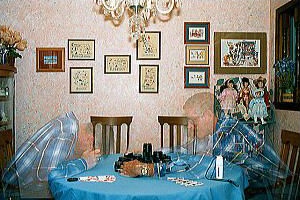Last Hand; Winner Takes All

Uploaded: September 27, 2001
OM-4; 35-105 f/3.5~4.5 Zuiko MC Zoom @ 35mm; T-32 flash w/diffuser and tilted for ceiling bounce; Royal Gold 100; f/5.6 @ 1/60th; Kokomo, IN, March 2000
John A. Lind May 26, 2019
Ajita,The T-32 is a dedicated flash and its output can be controlled by the camera. I set the film speed on the camera for 200 (twice that of the film being used). The sum of the two flashes, each for an ISO 200 exposure is the same as a single flash for an ISO 100 exposure on the same frame of film. Since the camera doesn't have a multiple exposure switch, I depressed the film rewind button while winding on to cock the shutter. This must be done carefully; even though the sprockets won't turn to advance the film, it can still move slightly because the takeup spool may be pulling on it slightly. In doing these, it's best to shoot a blank frame before making the multiple exposure, and then shoot a blank frame afterward to leave plenty of blank film on each side of it.
-- John #98186
Jen June 11, 2005
John, this is a cool shot. I like to take multiple exposurs with my camera, but I was wondering if you know how to take one without having that "ghosty" look, because I can't figure it out. #1458958John A. Lind June 11, 2005
Jen,The photograph must be composed for this . . . if the same thing is to appear in both halves, it should be completely in one half and completely in the other half.
-- John Lind #1459251
Jen June 11, 2005
Thank you very much John. I appreciate it. #1459270Sign up for an interactive online photography course to get critiques on your photos.
Discussions by Category: You can view photo discussions on various themes in the Community > Photo Discussions section of the site.
BetterPhoto Websites: If you see an orange website link directly under the photographer's name, it's totally okay. It's not spam. The reason: BetterPhoto is the one that offers these personal photography websites. We are supporting our clients with those links.
Unavailable EXIF: If there is no other information but 'Unavailable' in the EXIF (meaning no EXIF data exists with the photo), the 'Unavailable' blurb is not displayed. If there is any info, it shows. Many photos have the EXIF stripped out when people modify the image and resave it, before uploading.
The following truth is one of the core philosophies of BetterPhoto:
I hear, I forget.
I see, I remember.
I do, I understand.
You learn by doing. Take your next online photography class.
Copyright for this photo belongs solely to John A. Lind.
Images may not be copied, downloaded, or used in any way without the expressed, written permission of the photographer.
Log in to follow or message this photographer or report this photo.

I already have an account!
